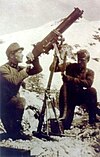Mannlicher M1893
| Romanian repeating rifle model 1893 | |
|---|---|
en bloc clip, integral box magazine |
The Mannlicher M1893 (or M93) is a
Development

Around the year 1890 the Romanian military started its search for a small bore,
The rifle's adoption caused some controversy, as despite the weapon's approval by King Carol I, General Constantin Budișteanu derided the Austrian rifle as un baton ("a stick") that required improvements. The rifle's bore, smaller than the usual Mannlicher product, also caused difficulties in finding compatible gunpowder.[7]
A carbine variant was also introduced, it was 98 centimetres (39 in) long and featured a bent bolt handle. It was used by cavalry and artillery units.
History
Deliveries started in 1893, and by 1907 more than 100,000 rifles were in service.
Following the war, 8mm M93 rifles were given as war reparations to Czechoslovakia and Yugoslavia. The Yugoslav rifles, designated as "Puška 8mm M93", were captured by the Germans in World War II. The Germans referred to these rifles as "8mm Puschka M93/30 Rumänisches".[1] The Romanian Mannlicher also saw some service in the Spanish Civil War by Spanish Republicans and captured by the Nationalists. It is unknown how these rifles were obtained.[12]
Portuguese Mannlicher M1896
The
In 1946 a few hundred of the Portuguese Mannlichers were adapted to fire the 5.6mm calibre (.22 Rimfire), for training.[13]
Mannlicher M1904 Export

In 1904, ŒWG would slightly modify the original M1893 design, primarily by rechambering it to the
Ammunition

6.5×53mmR: The 6.5×53mmR ammunition for the Romanian rifles was provided at first by Georg Roth, and Keller & Co.[17] Local production was also carried out at Pirotehnia Armatei, with a production rate of 200,000 cartridges per day registered in 1914.[18] Later, ammunition was also purchased from DWM, Manfréd Weiss and Hirtenberger Patronen. During the First World War, factories from France, Italy, the United Kingdom, and the United States also provided ammunition.[17]
World War 2-era
8×50mmR Mannlicher: 8×50mmR Mannlicher reloadable cartridge cases can be produced by reforming and trimming 8×56mmR Mannlicher or 7.62×54mmR Mosin–Nagant Russian brass. Standard .323" 8mm S-bullets are correct for this caliber though best results are obtained from open-base bullets that can expand to fit the .329" bore. RCBS offers both reforming and reloading dies. Rifles such as the Mannlicher M.95 using a stronger rotating-bolt design can be loaded to higher pressures.
Users

 Austria-Hungary
Austria-Hungary Czechoslovakia
Czechoslovakia Nazi Germany
Nazi Germany Kingdom of Portugal
Kingdom of Portugal Kingdom of Romania
Kingdom of Romania Spanish Republican faction
Spanish Republican faction Kingdom of Yugoslavia
Kingdom of Yugoslavia
Non-state users
- Macedonian revolutionaries: M1893 carbines used by various groups during the Macedonian Struggle between 1904 and 1908[22]
Gallery
-
Diagram of the Romanian Mannlicher M93
-
Romanian soldiers during the 1907 peasant revolt
-
Portuguese cavalry
-
BulgarianIMAROband armed with Mannlichers
See also
- Geweer M. 95 - Dutch Mannlicher variant, similar to the M1893
- Table of handgun and rifle cartridges
- 6.5×53mmR
- 8×50mmR Mannlicher
- 6.5×57mm Mauser
References
- ^ a b c d "Romanian Mannlicher M1893 Infantry Rifle". hungariae.com. Manowar. 8 December 2011. Retrieved 15 February 2015.
- ^ Bernard Fitzsimons (1978). The Illustrated encyclopedia of 20th century weapons and warfare. Columbia House. p. 1828.
- ISBN 9781440228926.
- ^ ISBN 9780275973391.
- ISBN 0873492021.
- ISBN 978-1-135-50701-5.
- ^ ISBN 978-0-674-02442-7.
- ^ Scafeș 2013, p. 73.
- ^ Scafeș 2013, pp. 65–66.
- ^ a b Ministerul Apărării Naționale Marele Stat Major Serviciul istoric (1934). "Documente–Anexe". România în războiul mondial : 1916-1919 (in Romanian). Vol. I. pp. 41, 45.
- ^ Scafeș 2013, p. 88.
- ^ "Foreign Rifles of the Spanish Republic, 1936-1939 – Surplused". Retrieved 29 June 2020.
- ^ a b "Portuguese 6.5 m/96 cartridges for the Mannlicher rifle". 25 April 2010.
- ^ a b "Steyr M1904 Export Mannlicher". 19 May 2008. Retrieved 23 March 2023.
- ISBN 0-85640-764-X.
- ^ "Mannlicher Repeating Rifle Model 1904 Contract". hungariae.com. Manowar. Retrieved 23 March 2023.
- ^ a b "6.5x53.5R Romanian Mannlicher 1892 & 1893". 27 October 2016.
- ^ Ministerul Apărării Naționale Marele Stat Major Serviciul istoric (1934). "I–VIII". România în războiul mondial : 1916-1919 (in Romanian). Vol. I. p. 51.
- ^ "303 British" (PDF).
- ^ "30-40 Krag" (PDF).
- ^ a b "6,5 x 57 R" (PDF).
- ISSN 0353-9628.
Bibliography
- Scafeș, Cornel (2013). "Efortul depus în vederea asigurării necesarului de armament, tehnică de luptă și muniții ale armatei române în anii neutralității (1914-1916)". București - Materiale de Istorie și Muzeografie (in Romanian) (XXVII/2013). ISSN 1222-7536.





